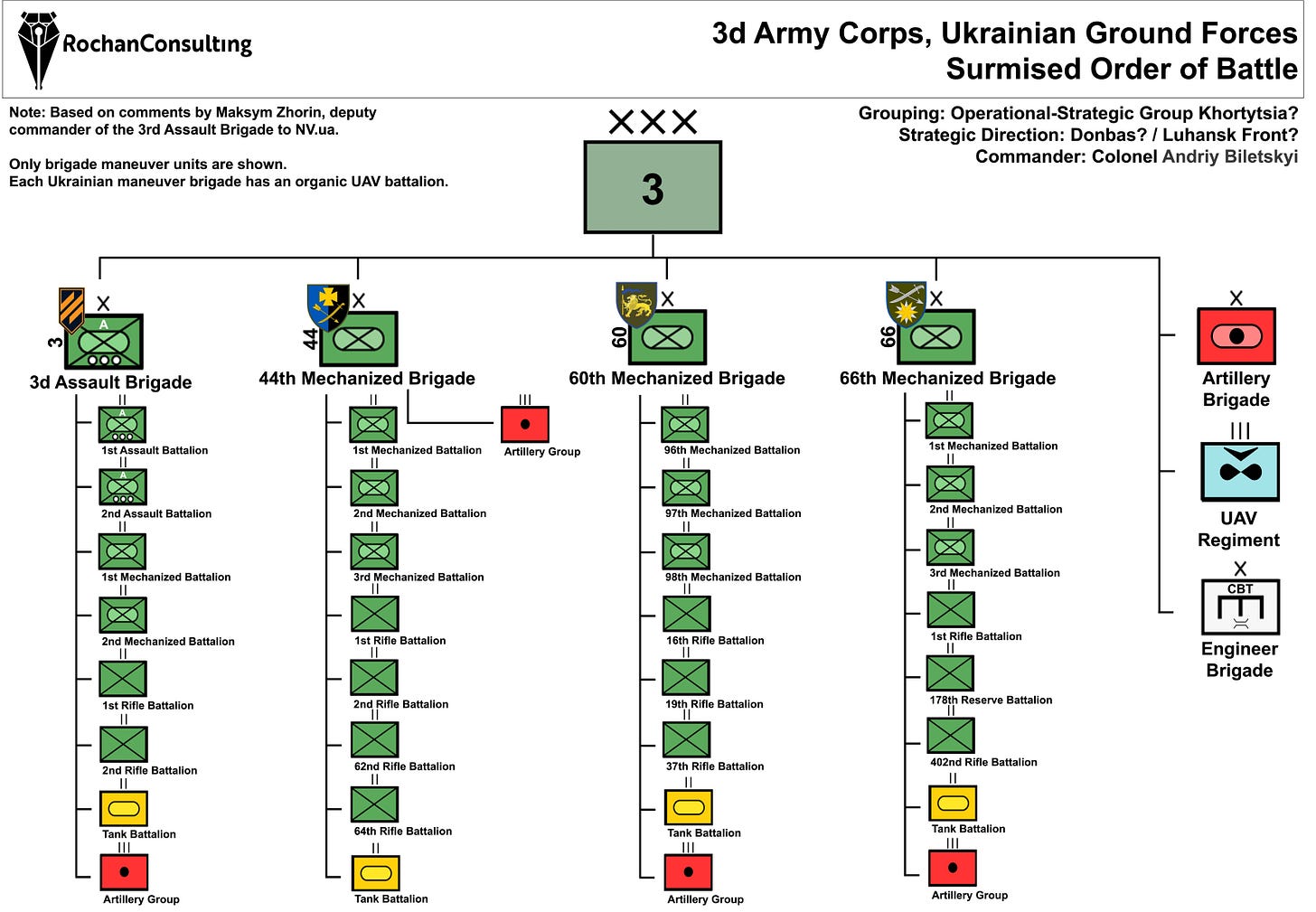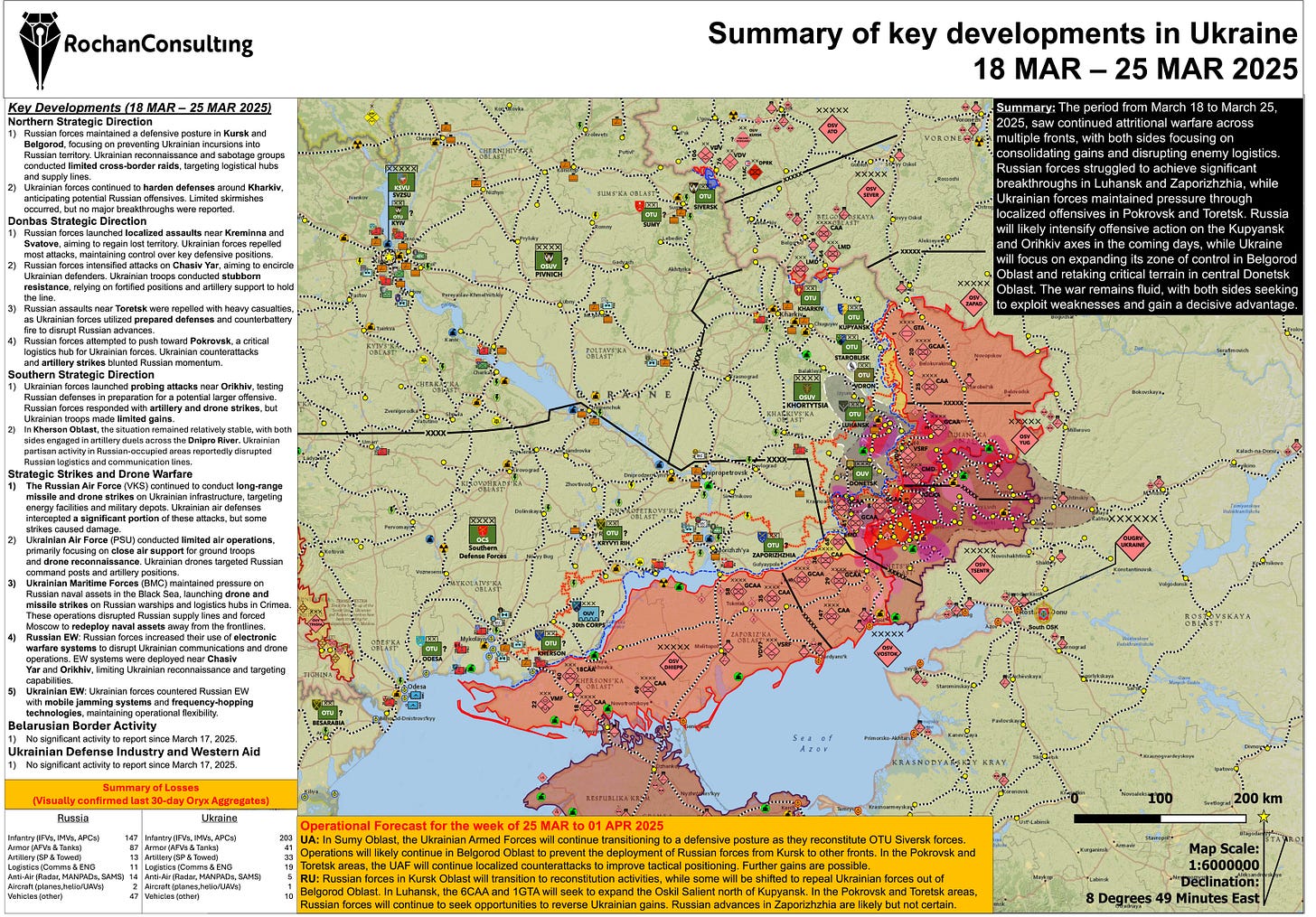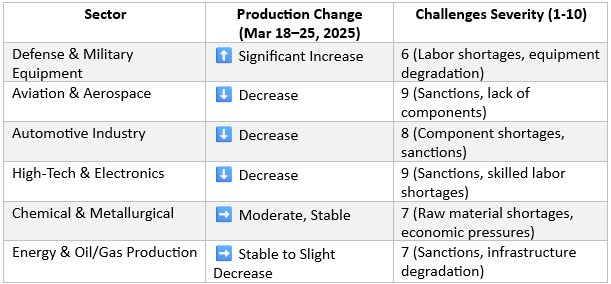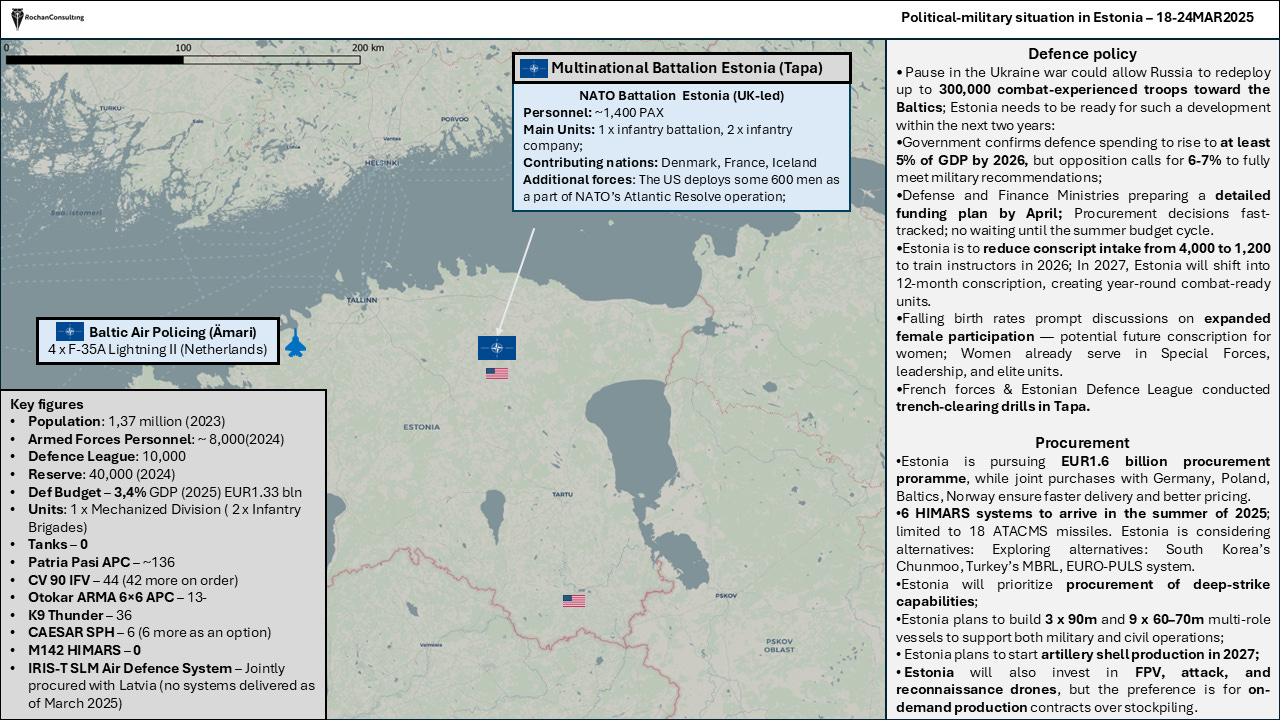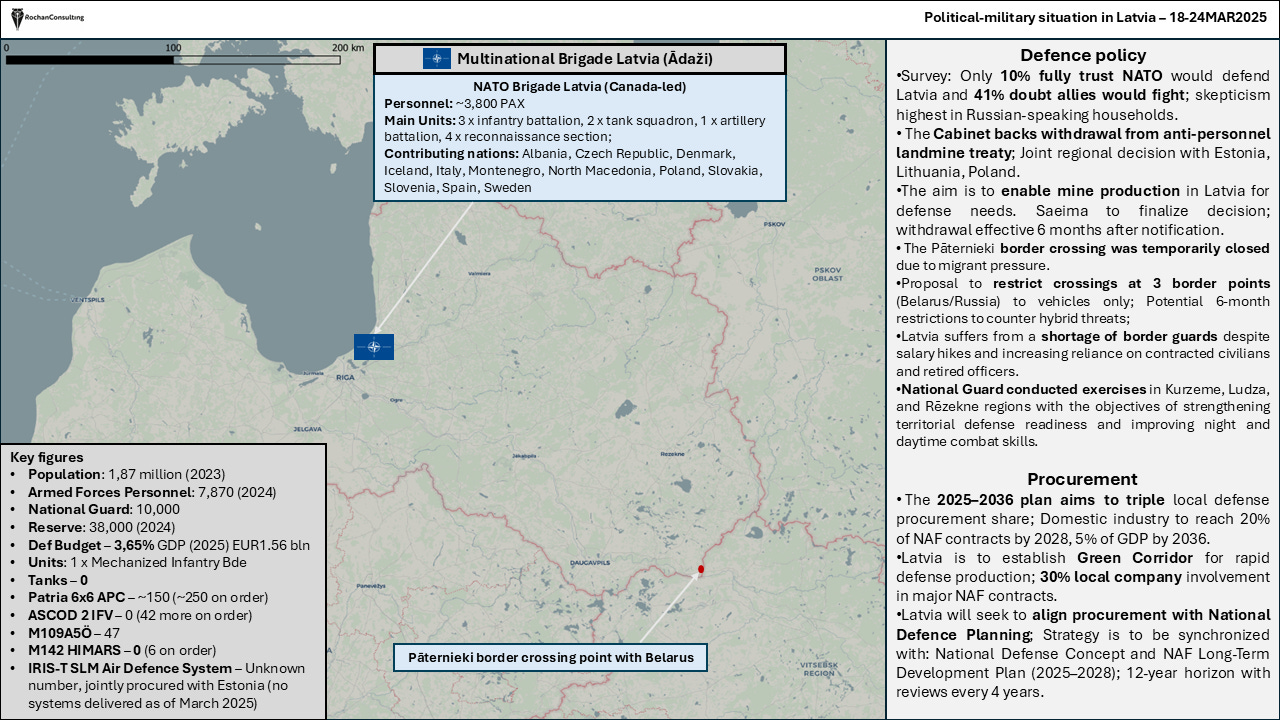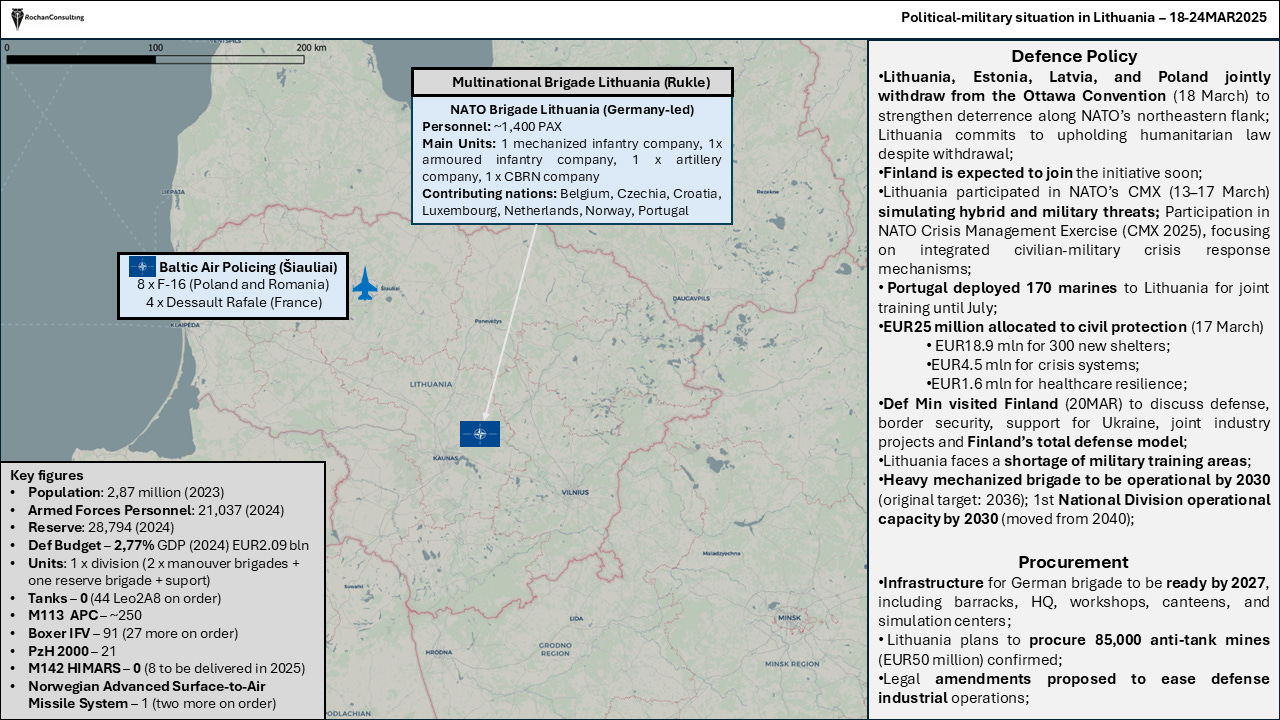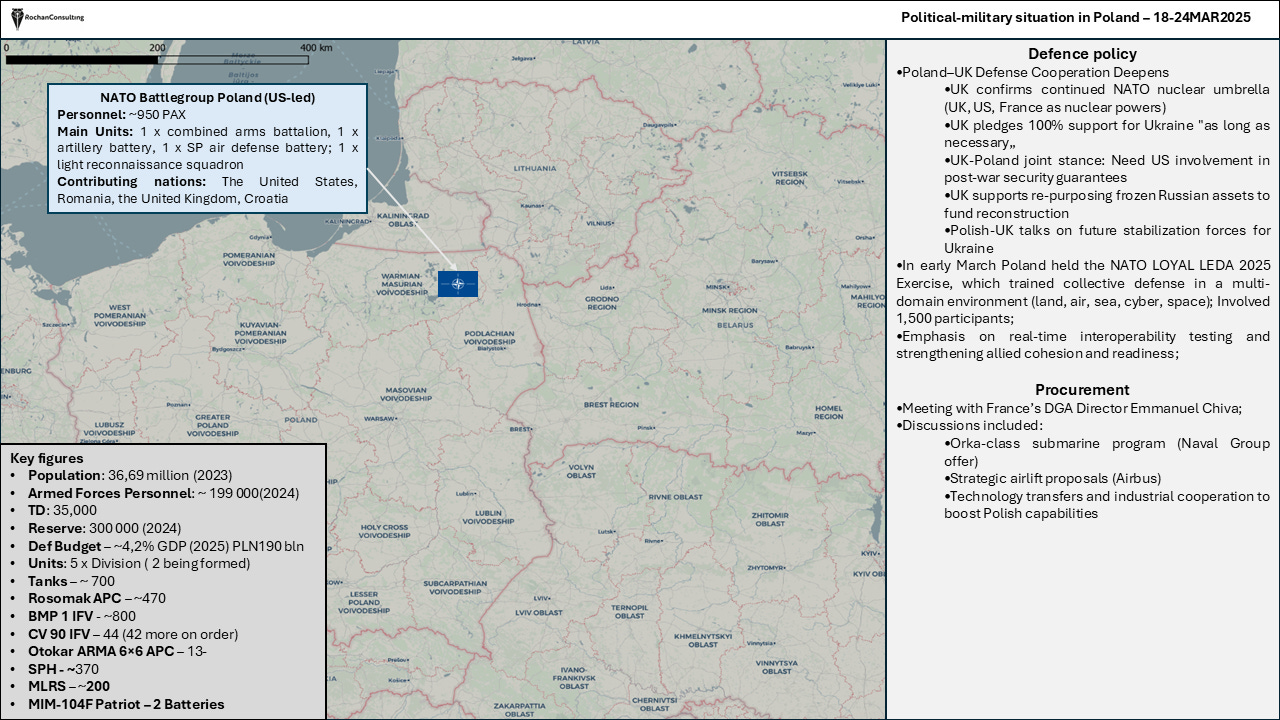Dear Friends, Colleagues, and Subscribers,
Back in January, we shared the exciting news that Major (Ret.) Ivan Torres had joined our team to help develop new analytical products. Since then, we’ve spoken extensively with many of you—our clients and readers—about your needs and the information gaps you face in your work.
Thanks for reading Ukraine Conflict Monitor! Subscribe for free to receive new posts and support my work.
The result of these conversations is Red Horizon, a weekly regional military and political research brief focused on Eastern Europe. Today, we’re pleased to announce the test launch of this new product.
Red Horizon will cover developments in Ukraine, Russia, Belarus, Poland, and the Baltic States. While the war in Ukraine remains the central focus, we are also closely tracking how regional actors are responding—militarily and politically—to the evolving Russian threat and the prospect of a significantly reduced U.S. military presence in Europe.
Our goal is to go beyond daily tactical updates. Red Horizon is designed to take an operational-strategic view of the regional security environment—connecting dots, highlighting emerging trends, and offering assessments that help you understand what’s driving change in Eastern Europe.
We’re still finalizing the structure and content of the brief—and this is where we’d love your input. If there’s something specific you’d like to see covered or if you have feedback on the format, please don’t hesitate to reach out. We’re building Red Horizon to serve professionals like you, and your insights are invaluable to us.
Thank you for your continued support, and we look forward to sharing Red Horizon with you.
Best regards,
Konrad
The analysis can be downloaded by clicking here. Otherwise, the full text was pasted below.
Red Horizon
Assessment of the geopolitical situation in Eastern Europe
(Weekly Regional Military & Political Research Brief)
Test Issue 1 – Weekly update
18 March - 24 March 2024
1. Executive Summary
Key developments
•Ukraine is forming the 3rd Army Corps based on the 3rd Assault Brigade, integrating veteran brigades, artillery, and UAV units to modernize its ineffective command and control system;
•Technical talks with the US in Saudi Arabia explored a potential maritime ceasefire, trade corridors, a line of control, and peacekeeping mechanisms, with Russia potentially open to a non-NATO UN peacekeeping force;
•Despite some recovery, Ukraine faces high inflation (12.9%), rising unemployment (10.5%), and economic fragility while relying on IMF support;
•Despite limited counterattacks, the Ukrainian frontline position remains vulnerable as Russia maintains the overall strategic initiative;
•Russia ramps up recruitment; Total verified combat deaths surpass 99,000;
•Mandatory defense production quotas and subsidies are imposed, worsening workforce shortages, infrastructure degradation, and sanctions-induced supply chain issues;
•No change in nuclear posture; however, increased militarization of the Arctic and Baltic and rhetoric against NATO signal long-term regional escalation risks;
•Belarus continued routine mobilizational exercises; Started preparations for the annual Victory Parade;
•Potential deployment of Russian Oreshnik missile systems by 2025; interest in acquiring TOS-1/2 thermobaric systems and Tornado-S MLRS;
•Poland accuses Belarus of state-sponsored migration pressure on its border;
•The three Baltic Countries and Poland announced their plan to withdraw from the Ottawa Convention (anti-personnel mine ban)
•Estonia plans to raise defense spending to 5% of GDP by 2026 (potentially 6–7%) amid fears of Russian redeployment if the Ukraine war pauses;
•Estonia reforms conscription—cutting intake but extending service to 12 months, facing personnel shortages, and debating women's mandatory conscription.
•Under the EUR1.6 billion armament program, Tallinn focuses on the procurement of artillery, HIMARS alternatives, naval upgrades, and local munitions production; Other priorities include investment in long-range and layered air defense and drone warfare capabilities;
•In Latvia, despite continued Belarusian-orchestrated migration pressure, critical staffing shortages in border security remain critical.
•The new 2025–2036 strategy targets tripling defense sector GDP contribution, focusing on innovation and EU supply chain integration;
•Lithuania plans to invest in shelters, crisis systems, and plans for 20,000 evacuees;
•Vilnius plans anti-tank mine purchases and the creation of defense industry clusters in collaboration with NATO partners; Accelerated heavy brigade development by 2030 and push for self-sufficiency in defense production;
•Poland plans to deepen defense industrial cooperation, including strategic airlift, submarines, and nuclear deterrence discussions with France;
•Hosted LOYAL LEDA 2025, testing NATO's large-scale defense capabilities in a multi-domain environment;
2. Regional Overview
The latest developments across Ukraine, Russia, Belarus, and NATO's Eastern Flank reflect a region steadily moving deeper into a phase of heightened militarization and strategic competition. Each actor's actions—whether driven by immediate conflict dynamics or longer-term security concerns—continue to reshape the security landscape in Eastern Europe and the Baltics.
In Ukraine, efforts to restructure its ground forces stand out as a significant development. The formation of the new 3rd Army Corps, built around experienced units like the 3rd Assault Brigade, marks a decisive move away from the existing ineffective command and control structure centered around the Operational-Tactical and Operational-Strategic Grouping of Forces. This reform aims to improve operational flexibility and better integrate drone and unmanned systems—an acknowledgment of the evolving nature of the battlefield. However, these efforts unfold against the backdrop of a challenging economic situation. High inflation, rising unemployment, and continued reliance on international financial support all pressure Ukraine's war-fighting capacity. Meanwhile, Kyiv's engagement in exploratory ceasefire talks—focused on maritime corridors and potential peacekeeping mechanisms—signals growing external pressure to freeze the conflict. Yet, the prospect of any settlement remains distant, particularly as Russia retains leverage through both military operations and diplomatic inflexibility.
Russia, for its part, continues doubling its war effort. Aggressive mobilization campaigns now include coercive recruitment methods, offering military service instead of criminal prosecution. The deepening toll is evident, with verified Russian combat deaths surpassing 99,000. Moscow's defense industry, strained but still functioning, has been ordered to prioritize military production at the expense of civilian output. While this ensures the flow of ammunition and equipment in the short term, it further erodes Russia's industrial base. It exposes the country to growing economic risks, particularly from sanctions and labor shortages. Despite these challenges, Russia maintains its aggressive posture, reinforcing its nuclear deterrent messaging and expanding military infrastructure in the Arctic and Baltic regions—clear signals of its intent to remain a dominant regional actor.
In Belarus, military cooperation with Russia deepens further. Ongoing exercises and interest in acquiring advanced Russian systems like the Oreshnik missile system and TOS-1/2 thermobaric weapons illustrate Minsk's increasing military reliance on Moscow. At the same time, Belarus remains an active player in hybrid warfare. The persistent use of state-sponsored migration pressure against Poland reflects Minsk's willingness to exploit non-military tools to achieve political objectives, keeping the region on edge.
These developments unfold in parallel with a significant shift in posture along NATO's Eastern Flank. Estonia, Latvia, Lithuania, and Poland are all accelerating defense reforms and procurement plans in response to what they perceive as an enduring and growing Russian threat. Estonia, in particular, faces internal debates over the scale of its military expansion, with defense spending now set to rise to 5% of GDP by 2026—and potentially higher. Recognizing the strategic vulnerability of demographic challenges, Estonia is also preparing for deeper structural reforms, including extending conscription terms and debating mandatory service for women.
Latvia and Lithuania, meanwhile, took the dramatic step of withdrawing from the Ottawa Convention, signaling a collective intent to reintroduce anti-personnel mines as a deterrent along their borders. Both nations face mounting hybrid pressures, particularly from Belarus, while grappling with internal capacity issues—whether staffing shortages in Latvia's border forces or the lack of adequate training grounds in Lithuania. Still, both countries are pushing forward with ambitious procurement plans designed to reduce reliance on external suppliers and foster domestic defense industries.
Poland continues to emerge as a central pillar of NATO's eastern defenses. Beyond hosting large-scale NATO exercises, Warsaw is actively expanding its defense cooperation with partners like the United Kingdom and France. These partnerships strengthen Poland's conventional capabilities and position it as a critical player in shaping post-war security guarantees for Ukraine.
Taken together, these trends underscore a region bracing for prolonged confrontation. The risk of immediate large-scale escalation remains contained, particularly with Russia's conventional forces heavily committed in Ukraine. However, hybrid threats, intensified defense preparations, and political maneuvering suggests that the Baltic Sea region and Eastern Europe are settling into a new strategic normal defined by sustained competition, growing defense investment, and persistent uncertainty.
The coming months will be pivotal in determining how effectively NATO's eastern members can close existing capability gaps, manage internal vulnerabilities, and navigate an increasingly complex security environment shaped by both Russian aggression and the war's uncertain trajectory in Ukraine.
3. Country-Specific Breakdown
3.1. Ukraine: Military & Political Update
Ukraine balances national unity with internal challenges under Zelensky's leadership, which faces pressure from both international relations and domestic issues. The coming months will be decisive for maintaining this balance while pursuing reforms and managing conflict. Economically, Ukraine faces hurdles in the agriculture, manufacturing, and energy sectors, yet international support and strategic policies aim to stabilize the economy. Sanctions on Russia provide a strategic advantage, but ongoing international assistance and adaptive economic strategies are necessary to navigate the wartime economy.
3.1.1. Military Situation Update: Ukrainian Armed Forces
On 14MAR25, Andriy Biletsky, the commander of the 3rd Assault Brigade, announced that his brigade would serve as the foundation for the new 3rd Army Corps. However, he did not provide any further details regarding its composition or whether the brigade would continue to function as an independent entity. Maksym Zhorin, deputy commander of the 3rd Assault Brigade, provided additional insights on the matter. In an interview with NV.ua, he discussed the ongoing development of the 3rd Army Corps.
Zhorin noted that the current corps units within the Ground Forces—the 9th, 10th, and 11th Army Corps—were operating inefficiently due to their dependence on an ineffective command and control system, which did not provide an effective framework for streamlining the C2 process. As a result, the General Staff of the Armed Forces of Ukraine is adopting an innovative approach to forming new corps, organizing them based on the core personnel, experience, and operational framework of veteran combat units like the 3rd Assault Brigade. The General Staff of the Armed Forces of Ukraine is currently working closely with the leadership of the 3rd Army Corps to finalize its leadership structure before integrating additional combat brigades into the corps. "The corps will not consist solely of the 3rd Assault Brigade but will also include other brigades that are already engaged in combat operations. While new units will be created, the corps will primarily rely on existing brigades," Zhorin explained.
According to Zhorin's statements, only key personnel from the 3rd Assault Brigade are involved in the formation of the corps, while the brigade itself continues to operate as an independent unit within it. In addition to the 3rd Assault Brigade, the corps is expected to include several maneuver brigades, an artillery brigade, engineering units, and various other support units. Given the significant role of drones on the battlefield and the current shortage of attack helicopters, it is unlikely that Army Aviation units will be part of the corps. However, it appears that the UAV battalion of the 3rd Assault Brigade will be expanded to become a separate regiment of unmanned systems for the corps, emphasizing the need for each corps to maintain its own independent UAV unit capable of supporting its different maneuver brigades.
Unconfirmed reports indicate that the 3rd Army Corps may include brigades that have worked alongside the 3rd Assault Brigade on the Svatove-Kreminna axis. Potential candidates comprise the 44th, 60th, and 66th Mechanized Brigades and the 3rd Tank Brigade. However, this is based solely on current unit deployments, and the official composition of the corps remains unknown. The 3rd Army Corps is likely a test case for the General Staff of the Armed Forces of Ukraine; its success will determine the final structure of the corps concept before it is applied across the ground forces. The transition to the corps system is complex and will require time. "We are now scaling from brigades to corps. If successful, this experience will be applied to the entire army. A great deal of work is underway, and many questions still need to be answered," Zhorin stated.
3.1.2. Ukrainian Ministry of Defence
On 24MAR25, Rustem Umerov, Ukraine's Minister of Defence, commented on X.com that a Ukrainian delegation had concluded a "productive and focused" meeting with American negotiators in Saudi Arabia for further discussions on a permanent ceasefire with Russia. Umerov headed the Ukrainian delegation, which included Pavlo Palisa, a presidential military advisor, Ihor Zhovka, a foreign policy advisory, and several military officers. Andrew Peek headed the US delegation from the National Security Council, and Michael Anton, the head of policy planning for the US State Department.
The Financial Times reported that these talks, to be followed by a conversation with US-Russia negotiators on Monday, were "technical" rather than high-level. The focus of the discussion is on a "maritime ceasefire" that would reestablish the movement of grain, fuel, and other commodities throughout the Black Sea. Upon settling on the guidelines for the renewal trade in the Black Sea, talks were to expand defining the "line of control", details of a peacekeeping force, and verification mechanisms to freeze the frontline. Future negotiations would address exchanging occupied territory for "permanent peace" and Ukrainian security guarantees. Although Russia has vehemently stated its opposition to a peacekeeping force comprise of NATO members, the New York Times reports that Feodor Voitolovsky, director of the Institute of World Economy and International Relations in Moscow, could accept a United Nations peacekeeping force in Ukraine that did not include troops from NATO countries.
3.1.3. Overall Economic Indicators
As of early March 2025, Ukraine's economy continues to confront significant challenges due to the ongoing war. The GDP is projected to reach approximately 183.59 billion USD by the end of 2025, indicating a degree of economic recovery despite the conflict. However, the country still struggles with high inflation, which rose to nearly 50% as of July 2024, and more recently stood at 12.9%. Unemployment remains a concern, with the rate climbing from over 9% in July 2024 to a more recent figure of 10.5%.
The Ukrainian government continues implementing various economic policies to maintain stability and support the war effort. The National Bank of Ukraine (NBU) remains focused on financial stability, guaranteeing the ongoing operation of banks even in challenging conditions. Ukraine's engagement with the International Monetary Fund (IMF) through the Program Monitoring with Board Involvement (PMB) continues to align fiscal and monetary policies to attract international financing. Support for the agricultural sector continues to be a priority, featuring streamlined state requirements and diminished bureaucratic obstacles to guarantee steady production.
3.2. Russia: Strategic Posture & Military Developments
Russia intensified military activity in Ukraine and Kursk Oblast. Increased troop numbers and strategic movements highlight a sustained commitment to operations in Ukraine. Russia's multifaceted force reconstitution includes aggressive recruitment, industrial adaptation, equipment modernization, and international cooperation. Despite challenges like tank production, Russia has progressed in artillery production and recruitment. The conflict in Ukraine continues to influence these efforts, leveraging domestic resources and international partnerships. NATO borders show ongoing military presence and infrastructure development, indicating readiness and potential buildup. Russian military strategy remains dynamic, posing challenges for both Ukraine and NATO. Russia's nuclear posture has grown more assertive, with doctrinal changes, increased deterrence activities, and aggressive rhetoric raising the risk of nuclear escalation. These developments have significant implications for global security and stability.
3.2.1. Recruitment and Mobilization
Russia continues its aggressive recruitment and mobilization efforts to support its military operations. Law enforcement raids continue in various regions of the country to serve draft notices to military-age males who have recently obtained their Russian citizenship but failed to register for military service. Likewise, regional courts continue to provide defendants with the option to avoid prosecution in lieu of military service. For example, since January 1, 2025, the Oryol Regional Court states it has granted 21 defendants the option of military service in exchange for prosecution, with the most common offenders receiving the options having been accused of fraud, theft, drug distribution, and making threats of violence. According to the independent Russian media outlet Mediazona and BBC News Russian, there are now 99,113 verified Russian soldiers killed in Ukraine, an increase of 1,119 soldiers from the March 17-25, 2025, reporting period. The largest category of casualties during the current reporting period is volunteer fighters, accounting for 24 percent of total losses.
3.2.2. Industrial Capacity and Production
On 20MAR25, the Russian government announced new directives mandating companies in key sectors (metallurgy, machinery, chemical industry) to prioritize state defense orders. This increase in defense production will likely focus on a significant expansion of ammunition, artillery shells, and armored vehicle production on an accelerated schedule. State subsidies and financial incentives will be prioritized for factories meeting increased production quotas to stabilize production output levels. Russian workforce shortages remain high, with supply chain disruptions continuing due to sanctions and logistical constraints, impeding timely access to critical raw materials such as rare-earth elements, specialized alloys, and high-grade steel. Domestic suppliers struggle to fully replace imported materials, causing production bottlenecks and lower-quality outputs; particularly affecting the aviation, automotive, electronics, and high-tech sectors.
The high demand to increase industrial output to sustain military operations in Ukraine will only exacerbate chronic underinvestment and accelerate equipment wear and tear and infrastructure degradation in key industrial sectors, requiring urgent maintenance and repair. Increased defense production quotas are likely to meet the demands of expanded defense-related manufacturing, enabling sustained military operations and replenishing equipment losses. However, intensified labor shortages, equipment degradation, and sanctions-induced supply disruptions may significantly undermine industrial productivity over the medium to long term, leading to high operating costs for Russian companies and forcing production cutbacks while sacrificing quality products. Although short-term production goals are achieved, the economy faces significant strain, exacerbated inflation, and potential future productivity collapse if current pressures remain unaddressed.
While immediate-term production increases have been successfully achieved through government mandates and resource reallocations, severe and persistent challenges remain. Sanctions-induced shortages, skilled labor depletion, infrastructure degradation, and overall economic pressures represent substantial hurdles, undermining long-term industrial sustainability and economic health. Without a strategic resolution to these critical issues, Russia's industrial base is likely to face significant constraints in maintaining current production levels, quality standards, and longer-term economic stability.
Timeline of Key Events (18–25MAR25):
-18MAR25: Government announces prioritization of defense production; mandatory production quotas issued.
-20MAR25: Subsidies and financial incentives for factories meeting new military production quotas.
-21MAR25: Expiration of previous mobilization exemptions, narrowing safety nets for industrial workers.
-22MAR25: New import substitution mandates implemented to counteract sanctions.
-24MAR25: Reports of increased overtime and shifts for industrial workers to maintain output amid labor shortages
3.2.3. Escalation Signals for Russian Strategic Forces
From 18-25MAR25, no verifiable changes occurred in Russian strategic forces' escalation protocols or alert levels. Although the war in Ukraine and relations with the West remain tense, Russian officials did not alter nuclear doctrine or launch procedures. Routine exercises and maintenance continued, with communication channels open to other nuclear powers. Despite geopolitical tensions, deterrence and de-escalation protocols were adhered to. However, due to the opacity of Russian operations, ongoing vigilance is required to detect any escalation signals.
3.3. Belarus: Military Cooperation & Political Risks
3.3.1. Defense Policy
Over the past seven days, the Belarusian Armed Forces have demonstrated a high level of commitment to training activities, reflecting the current phase of the military academic year. In addition to participating in the international command-staff exercise of the Collective Security Treaty Organisation (CSTO) between 17 -20MAR25, Belarus continued its own combat readiness inspection. During this period, the focus shifted from mobilizing wartime combined arms (sub)units—on 19MAR25, another group of 2,000 reservists was dismissed—to exercises involving the Air Force and Air Defence Forces (AFADF).
In particular, practical activities were likely carried out by the 483rd Security and Maintenance Battalion, responsible for establishing and protecting AFADF command posts. Additionally, at least one independent battalion-level tactical exercise and several training gatherings took place. Possibly due to the upcoming discharge of conscripts, a series of competitions were held to determine the best shooters, snipers, reconnaissance specialists, and BMP-2 and T-72 crews.
The Belarusian Armed Forces also officially commenced preparations for the annual Victory Parade, scheduled to take place in Minsk on 9 May.
3.3.2. Procurement
Last week, no direct reports emerged regarding Belarusian plans to acquire new weapons systems. However, on 18MAR25, the Secretary of the Belarusian State Security Council, Lt. Gen. Alexander Volfovich, suggested that Russian Oreshnik missile systems could be deployed in Belarus by the end of 2025. According to Volfovich, Belarus has already identified potential deployment sites and is actively producing launchers for the system.
Notably, a few days later, a video surfaced reportedly showing a Belarusian-made chassis for the Oreshnik system leaving the MZKT plant in Minsk. Additionally, the Belarusian Military-Political Review—a semi-official outlet comprising former Russian and Belarusian servicemen—reported that the Belarusian Armed Forces are interested in acquiring Russian TOS-1/2 thermobaric systems and Tornado-S multiple launch rocket systems (MLRS), both of which have proven effective in the ongoing Russo-Ukrainian conflict.
Regarding infrastructure, Belarus continued developing a new military town near the city of Gomel, with forest-clearing operations now underway.
3.3.3. Hybrid threats
Over the past seven days, no new reports directly implicating Belarus in hybrid threat activities have surfaced. However, during a visit to the border region on 22MAR25, Polish Prime Minister Donald Tusk claimed that the ongoing migration pressure on Poland's border was under the "organizational and political patronage" of President Alexander Lukashenko's administration.
Tusk also reported that Polish law enforcement agencies had achieved a 98 percent success rate in preventing illegal border crossings from Belarus.
3.4. NATO's Eastern Flank
3.4.1. Estonia
3.4.1.1 Defense Policy
Estonia entered the past week with a growing urgency to accelerate its defense posture, driven by escalating security concerns and fears of a potential pause in the war in Ukraine. Prime Minister Kristen Michal warned that any halt in fighting would enable Russia to reposition experienced combat units toward Estonia, posing a direct threat to the Baltic states. According to EDF Commander Maj. Gen. Andrus Merilo, Russia could swiftly redeploy 250,000–300,000 troops from Ukraine — battle-hardened and ready — leaving Estonia with a narrow window to bolster its readiness.
Responding to these warnings, the government confirmed plans on 19MAR25 to raise defense spending to at least 5% of GDP starting in 2026, the highest in the EU after Poland. Yet, even this unprecedented increase may not be enough. Opposition leaders argued that to fully implement the military's recommendations, Estonia must aim higher — potentially reaching 6-7% of GDP. They criticized the government for years of underinvestment, suggesting that indecision has already driven up costs as global demand for ammunition and equipment surges.
Recognizing the urgency, Estonia's leadership pledged to accelerate decision-making and capability development. A detailed financing plan is now in preparation, due in April, with Defense Minister Hanno Pevkur confirming that procurement decisions, typically left for the summer, will be fast-tracked. Prime Minister Michal summed up Estonia's position bluntly: facing EU budget rule violations is preferable to facing war on Estonian soil.
Meanwhile, the country faces internal challenges in strengthening its military force structure. The EDF announced significant reforms to its conscription model. In 2026, the annual conscript intake will drop from 4,000 to 1,200, freeing up instructors to retrain and refocus on wartime tasks. By 2027, Estonia will shift to a 12-month service model — abandoning the old 8-month system — ensuring that combat-ready units are available year-round.
Personnel shortages remain a growing concern. With 500 vacancies in the EDF and many experienced soldiers set to retire, Estonia plans to boost recruitment, enhance career pathways, and review salaries to retain skilled personnel. These changes reflect the broader reality: the defense of Estonia increasingly depends not just on new weapons but also on people.
The country is also beginning to confront demographic realities. Falling birth rates could force Estonia to expand the role of women in the military, including debates over potential mandatory conscription for women — a model inspired by Israel. Women already serve in elite units, but future force needs may make their expanded participation essential.
Against this backdrop, Estonia continues to work closely with its allies. Remarks from a UK defense minister about potential troop redeployments to Ukraine sparked concern midweek, but both Estonian and British officials quickly reaffirmed that the NATO presence on Estonia's soil will not be reduced. Pevkur emphasized that the UK-led NATO battlegroup remains fully committed, with major exercises like Siil scheduled for this summer.
Cybersecurity threats also reemerged, with the Information System Authority (RIA) warning on 19MAR25 about a new malware campaign disguised as ETV copyright claims. The incident underlined the hybrid nature of the threat Estonia faces — from cyberattacks to conventional military risks.
3.4.1.2 Procurement
Parallel to its defense policy decisions, Estonia is pushing forward one of the largest procurement programs in its post-independence history — a EUR1.6 billion effort designed to transform its military capabilities.
The week saw a growing debate over the pace of ammunition procurement, with critics arguing that joint European initiatives may delay deliveries. Defense Minister Pevkur pushed back, defending the multi-country approach — including joint purchases with Germany through the European Sky Shield Initiative — as a way to secure better prices and avoid supply bottlenecks. Echoing past lessons, Pevkur cited how Finland outbid Estonia for vaccines, a scenario Estonia aims to avoid with ammunition.
However, ammunition is just one part of Estonia's expanding arsenal. Discussions intensified over the future of Estonia's HIMARS deep-strike capabilities. While six HIMARS launchers are due this summer, their impact is limited by a cap on U.S.-approved missile deliveries — just 18 ATACMS missiles. With demand soaring globally, Estonia is now weighing alternative systems from South Korea (Chunmoo), Turkey (MBRL), and the Israeli-European EURO-PULS project.
Up to EUR500 million is on the table, but the decision is more complex than price and delivery timelines. Estonia must also consider logistics, long-term support, and strategic alliances — with some systems produced in Europe and others in Asia. Pevkur signaled that time is short, and the Cabinet must resolve this soon to avoid leaving the country exposed.
Naval modernization plans also advanced, with Pevkur outlining a vision for new domestically-built ships. Estonia hopes to construct three 90-meter vessels and nine smaller multi-purpose ships, leveraging local shipyards like Baltic Workboats and BLRT. A Swedish study will guide final decisions, ensuring that new vessels support both defense and civil tasks like border control and pollution response.
Meanwhile, Estonia is moving rapidly to build its own munitions production capacity. On 20MAR25, the government confirmed that an international tender would launch for artillery shell production in April, aiming for projectile manufacturing to begin by 2027. Over 20 companies have already shown interest, attracted by Estonia's promise of building the necessary infrastructure and guaranteeing domestic defense orders.
This effort complements the mini-industrial park at Ämari airbase (also the base for Baltic Air Policing), where OÜ Nitrotol will begin producing charges and mines this summer. Estonia also plans to establish a military explosives factory, further securing its ammunition supply chain — a move designed to protect against future shortages and bolster independence from external suppliers.
Among the most critical areas of investment is layered air defense. Medium-range systems are already procured, but officials acknowledge that long-range air defense — capable of intercepting ballistic missiles — is now essential. Pevkur hoped that manufacturers would soon deliver upgrades to systems like IRIS-T to meet these needs.
Complementing these high-end systems, Estonia is prioritizing the development of drone warfare capabilities, including strike and reconnaissance drones. Drawing on lessons from Ukraine, the EDF seeks a flexible model emphasizing on-demand production contracts rather than large stockpiles.
The week ended with an important joint exercise in Tapa, where French forces and Estonia's Defense League practiced trench-clearing operations — a stark reminder of how quickly Ukraine lessons shape Estonia's training. French troops showcased their use of drones for reconnaissance and coordination, underlining the changing face of modern warfare.
3.4.2. Latvia
3.4.2.1. Defense Policy
Latvia's national security discussions intensified this week, reflecting both external pressures and domestic concerns about resilience. A newly released survey on 18MAR25 revealed a worrying lack of public confidence in NATO's "ironclad" security guarantee. Only 10% of Latvians fully trust NATO allies would fight for Latvia if invaded, while 41% doubt such a response. Russian-speaking households, in particular, were significantly more skeptical, underscoring internal social divisions that could impact Latvia's defense cohesion.
Compounding these anxieties, Defense Minister Andris Sprūds announced Latvia's intention to withdraw from the Ottawa Convention on anti-personnel landmines, joining Estonia, Lithuania, and Poland in a coordinated regional move. The decision, formalized by the Cabinet on 18MAR25, is driven by the recognition that Russia's aggression — regardless of Ukraine's outcome — continues to pose a long-term threat. Withdrawal would enable Latvia to produce its own anti-personnel mines, bolstering border defenses while maintaining humanitarian law commitments. The final decision now rests with the Saeima, which is expected to review the draft legislation in the coming weeks.
While strategic decisions dominate the agenda, Latvia is simultaneously grappling with the hybrid threat on its eastern border. On 17MAR25, authorities temporarily closed the Pāternieki border crossing with Belarus after detecting a potential surge in illegal crossings — a reminder of Belarus's ongoing use of migrants as a weapon. Border Guard Chief Guntis Pujāts warned that Latvia might restrict crossings at Pāternieki, Terehova, and Grebņeva for six months, limiting movement to vehicles only. These measures aim to counteract orchestrated border pressure by Belarus, mirroring tactics used against Poland and Finland.
Yet, Latvia's ability to enforce its border security is being tested by persistent staff shortages within the Border Guard. Despite salary hikes and relaxed recruitment standards, critical vacancies remain — especially in Riga, Ventspils, and at border surveillance points. The service increasingly relies on contracted civilians and retired officers to monitor video feeds and support frontline operations. Officials admit that without new incentives and better infrastructure, filling deputy commander roles and specialized positions will remain difficult.
Even as the pressure mounted, Latvia continued strengthening its defense readiness through joint training. This week, "Verboom VIII" — a multinational NATO engineer exercise — brought together Latvia, Estonia, and Lithuania forces and deployed NATO battlegroups at the Ādaži training ground. Running 17–23MAR25, the drills focused on combat engineering skills vital for reinforcing Baltic defenses.
Meanwhile, Latvia's National Guard conducted simultaneous exercises in the Kurzeme, Ludza, and Rēzekne regions (22–23MAR25). These battalion-level drills sharpened both individual skills and collective combat capabilities, ensuring territorial defense readiness amid the rising regional threat.
3.4.2.2. Procurement
Latvia's defense ambitions took a decisive leap forward this week with unveiling the Defense Industry and Innovation Support Strategy (2025–2036) — a sweeping roadmap designed to triple local defense procurement and massively expand the sector's contribution to GDP.
Approved by the Cabinet on 18MAR25, the strategy sets a target of raising domestic defense industry purchases to 20% by 2028 and 30% involvement in large NAF contracts. By 2036, defense sector output is expected to contribute 5% of Latvia's GDP — up from the current 1%.
To achieve this, Latvia is promising to increase innovation funding to 1.5% of the defense budget by 2028 and 3% by 2036. The strategy includes bold initiatives like a "Green Corridor" to fast-track defense production capacity, optimizing the life cycle management of military equipment, and regular engagement with industry to align procurement plans.
Prime Minister Evika Siliņa emphasized that this effort isn't just about defense but about economic growth and securing Latvia's place in Europe's defense supply chain. "We already see alignment at the EU level for greater defense investment and rapid development of military industries," she noted.
NATO's defense attachés were briefed on the plan during a 20MAR25 meeting in Riga. They also visited the NATO Force Integration Unit, underscoring the growing importance of Latvia's role in coordinating high-readiness deployments.
Looking ahead, the strategy ties directly into Latvia's National Defense Concept and Armed Forces Long-Term Development Plan (2025–2028) — ensuring that procurement, industry growth, and capability development remain synchronized for the next 12 years.
3.4.3. Lithuania
3.4.3.1 Defense Policy
Last week, Lithuania continued to recalibrate its defense policy in response to evolving regional threats. A significant milestone came on 18MAR25, when Lithuania, alongside Poland, Latvia, and Estonia, jointly announced their withdrawal from the Ottawa Convention on anti-personnel mines. Citing Russia's extensive use of mines in Ukraine and the growing security risks along NATO's northeastern flank, the move was presented as a regional signal of intent to strengthen deterrence capabilities. Defense Minister Dovilė Šakalienė underscored the necessity of having all defense tools available while reaffirming Lithuania's commitment to humanitarian law and civilian protection.
Lithuania also participated in NATO's CMX 2025 crisis management exercise (13–17MAR25), testing its national-level crisis decision-making amid simulated hybrid and military threats. Prime Minister Laimonas Ruys lauded the exercise for improving coordination between national institutions and allies, emphasizing that rapid deployment of resources and host nation support are critical for crisis scenarios.
As NATO presence on Lithuanian soil continues to grow, Portugal deployed 170 marines this week to bolster deterrence measures. The contingent will train alongside Lithuanian forces until July, enhancing interoperability.
In parallel, Lithuania advanced its civil defense capabilities. On 17MAR25, Defense Minister Šakalienė signed a EUR25 million package supporting shelter construction, crisis systems, and healthcare resilience—plans include 300 new shelters and provisions for 20,000 evacuees.
Meanwhile, Minister Šakalienė's visit to Finland reinforced Lithuania's interest in adopting Helsinki's comprehensive defense model, which prepares the nation for high-intensity warfare. Lithuanian-Finnish talks also covered EU defense capability growth, strengthening transatlantic ties, and continued support for Ukraine. The countries reaffirmed commitments to joint training and border fortifications, while cooperation with Finnish industry, like NAMMO, gained momentum.
However, domestic challenges surfaced as the military warned of a critical shortage of training grounds. Current facilities cannot accommodate Lithuania's expanding forces and NATO allies. A new, large-scale training area—likely in southern Lithuania—is now under review, despite local opposition over environmental concerns. Prime Minister Gintautas Paluckas stressed the strategic necessity of such a facility, especially for armored and artillery units supporting the German brigade.
Finally, reflecting on her first 100 days in office, Minister Šakalienė highlighted major defense strides—raising defense spending to 4% of GDP, increasing reserve training targets, advancing regional fortifications, and launching cyber defense and underwater infrastructure security initiatives. Still, she acknowledged more work ahead, particularly in soldier recruitment, social guarantees, and fast-tracking defense industry development.
3.4.3.2 Procurement
Lithuania's defense procurement efforts accelerated significantly last week, driven by the expanded budget and urgent strategic needs. Central to this was the procurement launch for Phase II of the Rūdninkai Military Campus—a EUR1.8 billion public-private partnership aimed at readying infrastructure for the German brigade by 2027. The plan covers living quarters, workshops, training facilities, and high-tech simulation centers, with priority given to Lithuanian companies to bolster the domestic economy.
In parallel, Lithuania deepened its commitment to fortifying the eastern flank. Plans were unveiled to purchase 85,000 anti-tank mines worth EUR50 million, alongside the development of local explosives production. This is part of the broader "East Shield" and "Baltic Defence Line" initiative—multi-layered border defenses that Lithuania seeks to co-finance with the European Union.
Lithuania's ambitious defense industry expansion strategy was also under the spotlight. During the Defence and Security Industry Council meeting on 20MAR25, officials discussed legislative amendments supporting a "green corridor" for defense projects. The proposals aim to simplify land-use regulations, ease weapons component controls, and foster industrial clusters capable of producing critical military equipment domestically.
Minister Šakalienė confirmed plans to create four defense industry clusters, establishing joint ventures with the US, Germany, Ukraine, and Nordic partners. Future production lines could include explosives, drones, and armored vehicle components—part of Lithuania's push for deeper integration into NATO supply chains.
Lithuania remains committed to meeting NATO standards by developing a heavy brigade by 2030, six years earlier than planned. Investments in air defense, long-range strike capability, and cyber defense will position Lithuania as a front-line contributor to European security.
3.4.4. Poland
3.4.1.1. Defense Policy
Poland continued strengthening its international defense partnerships this week, with notable developments in relations with the United Kingdom. During a session of the Polish Parliament's Foreign Affairs and NATO Cooperation Subcommittee, British Ambassador Anna Clunes outlined London's growing security engagement in Europe. She emphasized that the United Kingdom views NATO as the cornerstone of its defense strategy, demonstrated by Prime Minister Keir Starmer's "NATO First" policy. In a significant move, the UK will raise its defense spending from 2.3% to 2.5% of GDP by 2027 and aims to reach 3% by 2029. Though these figures differ from Poland's planned 5% of GDP on defense, the Ambassador highlighted that this represents an additional GBP13 billion annually for the UK's armed forces.
Ambassador Clunes reaffirmed the UK's nuclear deterrent commitment to NATO, reminding that since 1962, British nuclear capabilities have been at the Alliance's disposal—alongside those of the US and France—ensuring protection under a collective nuclear umbrella.
Security guarantees for Ukraine remained a central theme. Ambassador Clunes stressed the UK's unwavering support for Kyiv, pledging to assist "100% as long as necessary." She noted that any terms to end the war must be acceptable to Ukraine while also underlining the importance of sustained diplomatic pressure and sanctions against Russia. The potential use of frozen Russian assets was raised as a topic of ongoing discussion. Poland was recognized as a key partner in developing post-war security guarantees for Ukraine, with both nations agreeing on the need for US involvement and expressing readiness to contribute to a future stabilization force.
Polish-French defense relations also gained momentum this week. On 18MAR25, a meeting between Poland's Deputy Defense Minister Paweł Bejda and Emmanuel Chiva, Director General of France's Directorate General of Armaments (DGA), took place in Warsaw. Talks focused on the Orka next-generation submarine program, with France's Naval Group presenting its offer. Discussions also covered strategic airlift solutions, with Airbus showcasing proposals, and broader industrial cooperation, including technology transfers and joint production aimed at strengthening the Polish Armed Forces' operational capabilities.
3.4.1.2. Procurement
On the operational front, Poland played host to one of NATO's key collective defense exercises, LOYAL LEDA 2025, held from 3-14MAR25 at the NATO Joint Force Training Centre in Bydgoszcz. Nearly 1,500 personnel, including over 600 military and civilian experts from 27 NATO countries, participated. The exercise, 18 months in the making, was designed to test NATO's readiness for large-scale collective defense operations in a complex, multi-domain environment.
Participants, including the Multinational Corps Southeast and the NATO Rapid Deployable Corps-Türkiye, were challenged by a sophisticated scenario covering land, air, maritime, space, cyber, and information domains. NATO's Allied Land Command oversaw the event, while the JFTC led the exercise execution. The environment simulated real-world pressures, testing decision-making under stress and refining interoperability procedures. Response cells introduced dynamic challenges, while an opposing force (OPFOR) added realism, forcing participants to adapt and solve complex problems across political, military, economic, social, and critical infrastructure areas.
General Petr Svoboda, Deputy Commander of the JFTC, highlighted that the exercise strengthened NATO's operational readiness and deepened bonds among allies. Senior NATO leaders, including Lieutenant General Jez Bennett and Major General Bogdan Rycerski, praised the successful outcome, underscoring the Alliance's preparedness to face evolving security threats.
Overall, the week reinforced Poland's role as a vital player in NATO's eastern flank defense, while diplomatic and industrial engagements with the UK and France opened new avenues for technological cooperation and military modernization.
4. Strategic Risk Assessment
4.1. Potential Escalation Triggers
We do not expect an escalation of tensions between Russia and NATO forces in Eastern Europe. The bulk of Russia's conventional military capability remains engaged in combat operations in Ukraine. Our baseline assessment is that as long as the war in Ukraine continues, Russia will not have the capacity to launch a large-scale conventional military operation against NATO. However, Russian sabotage operations, hybrid warfare activities, and other forms of unconventional aggression remain possible.
Belarusian military activities remain heightened. However, these are linked to the ongoing mobilization exercise and do not pose a threat to neighboring countries. Our assessment remains that Belarus would likely require extensive Russian support to initiate military operations in any direction and, as such, it would not be able to operate independently of Russia.
From a military standpoint, we have observed no significant changes in NATO's posture. The Alliance remains committed to defending the Baltic States and Poland and continues developing its regional capabilities and presence. The enhanced Forward Presence Battlegroups in Lithuania and Latvia have transitioned into NATO Multinational Brigades, increasing the size of NATO forces in those countries to approximately 5,000 troops total. More forces will be deployed throughout 2025-26, especially in Lithuania, which is preparing to accommodate a German brigade.
Uncertainty lingers over the future of the US military presence in Europe. In recent weeks, European politicians have been confronted with stark questions regarding Washington's willingness to support and defend Europe conventionally and unconventionally. In response, increased defense spending, backed by the EU, aims to mitigate some of these concerns.
4.2. Ukraine Scenario Forecasting for the week of 25MAR-1APR2025
• Most likely scenario (60-80%): The upcoming week will be characterized by intense fighting, particularly in southern Donetsk Oblast, the Kursk region, and the Belgorod Oblast. Ukrainian forces are expected to press their advantage in the Belgorod Oblast, attempting to prevent the deployment of substantial Russian troops from the Kursk region to other critical fronts while also focusing on limited counteroffensives in the Pokrovsk and Toretsk region to regain critical ground, relying on drones and AI-driven systems to offset manpower shortages. Drier spring weather is expected to enhance mobility for Ukrainian armored and mechanized units, which could facilitate faster advances. Overall, the war is expected to remain in an attritional state, with both sides facing significant challenges in maintaining their current levels of military engagement and no major territorial shifts anticipated within this one-week period.
• Worst-case scenario (10-20%): Following the recapture of Kursk, Russian forces launch an assault into the Ukrainian Sumy Oblast. A major incursion into Sumy Oblast could severely disrupt the Ukrainian long-range strike campaign against key Russian economic and military infrastructure sustaining its war effort. Severe ammunition shortages, exacerbated by disruptions in Western military aid, could critically hamper Ukraine's defensive capabilities. This shortage, combined with troop level deficiencies and internal procurement challenges, may leave Ukrainian forces vulnerable to an intensified Russian offensive, particularly in southern Donetsk Oblast and Sumy Oblast. Capitalizing on their recent territorial gains and numerical superiority, Russian forces might exploit these vulnerabilities to achieve significant breakthroughs, notably in Zaporizhzhia or the northern Donetsk Oblasts, potentially threatening key strategic positions or critical infrastructure. This could result in substantial territorial losses for Ukraine, demoralization of its forces, and a shift in the war's momentum decisively in Russia's favor, potentially bringing Ukraine closer to the point of strategic collapse.
• Best-case scenario (10-20%): Leveraging their advanced drone warfare capabilities and AI-driven systems, Ukrainian forces could significantly disrupt Russian supply lines and logistics, particularly by exploiting the adverse weather conditions that are expected to hamper Russian operations. The integration of AI in drone operations, which has increased target engagement success rates to 70-80%, could lead to highly effective strikes against key Russian positions and equipment. Ukrainian defensive capabilities, bolstered by well-constructed fortifications and strategic use of terrain, could successfully repel Russian advances, especially in southern Donetsk Oblast and the Sumy region. The resumption of US military aid, combined with increased support from European allies like Norway, could alleviate ammunition shortages and provide Ukraine with the necessary resources to launch limited but effective counter-offensives. Ukrainian forces might achieve significant territorial gains by exploiting gaps in Russian lines and targeting their logistical vulnerabilities, potentially reclaiming recently lost areas in Toretsk, Chasiv Yar, Kupyansk, and Pokrovsk. This scenario could see Ukraine regaining the initiative, boosting troop morale, and setting the stage for a more favorable long-term strategic position in the conflict.
5. Key Takeaways & Recommendations
Next week, the intensity of Russian ground assaults in Donetsk Oblast may increase as improving weather conditions favor offensive operations. Pokrovsk's surroundings remain the likely focal point, though other sectors could see opportunistic pushes. Simultaneously, Russian responses to Ukrainian raids into the Kursk and Belgorod Oblasts warrant monitoring. Although these incursions remain limited, any signs of Russian force reallocations or reinforcement movements in these areas could signal a shift in priorities. Additionally, the Belarusian military's ongoing annual exercises should be observed for sudden changes in scope, although current patterns remain routine.
What to watch:
•Potential Russian offensive surges in Donetsk Oblast, especially near Toretsk, Velyka Novosilka, Pokrovsk, and Chasiv Yar;
•Russian troop movements near Belgorod/Kursk, particularly signs of counteraction or troop reinforcements to contain the Ukrainian raids.
•The increased tempo of Ukrainian long-range drone attacks on critical Russian infrastructure.
•Russian long-range strikes on civilan targets to compel Ukraine to accommodate Russian political objectives;
Implications:
•Russia's operational tempo may grow in Donetsk as the weather improves, but they may struggle against well-equipped Ukrainian FPV teams and artillery strikes;
•Ukraine's cross-border operations serve more as a distraction than a real threat to Russian control lines. Still, they may force Russia to redeploy some forces from the front.
•Regional stability remains intact. Belarus's annual exercises align with routine patterns and are not indicative of escalation.
Recommended actions:
•Monitor Russian force allocations/redeployments—any large redeployments from Kursk/Belgorod could signal preparation for localized offensive or defensive actions.
•Track the impact of seasonal changes—as spring approaches, anticipate new operational challenges (mud season, re-opening of maneuver corridors).
•Track Ukrainian and Russian long-range strikes and their impact
6. Appendices
Thanks for reading Ukraine Conflict Monitor! Subscribe for free to receive new posts and support my work.
